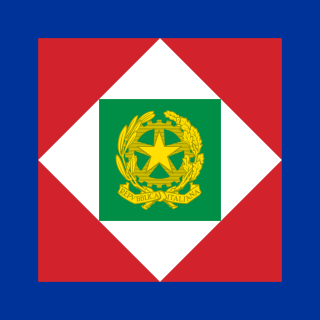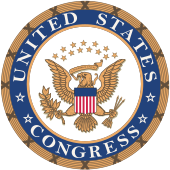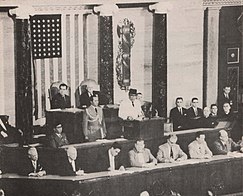
The president pro tempore of the United States Senate is the second-highest-ranking official of the United States Senate, after the vice president. According to Article One, Section Three of the United States Constitution, the vice president of the United States is the president of the Senate, and the Senate must choose a president pro tempore to act in the vice president's absence.

In the United States, the Electoral College is the group of presidential electors that is formed every four years for the sole purpose of voting for the president and vice president. The process is described in Article II of the U.S. Constitution. Each state appoints electors using legal procedures determined by its legislature, equal in number to its congressional delegation totaling 535 electors. A 1961 amendment granted the federal District of Columbia three electors. Of the current 538 electors, a simple majority of 270 or more electoral votes is required to elect the president and vice president. If no candidate achieves a majority there, a contingent election is held by the House of Representatives to elect the president and by the Senate to elect the vice president. Federal office holders, including senators and representatives, cannot be electors.
President of the Senate is a title often given to the presiding officer of a senate. It corresponds to the speaker in some other assemblies.

The speaker of a deliberative assembly, especially a legislative body, is its presiding officer, or the chair. The title was first used in 1377 in England.

The Electoral Commission, sometimes referred to as the Hayes-Tilden or Tilden-Hayes Electoral Commission, was a temporary body created by the United States Congress on January 29, 1877, to resolve the disputed United States presidential election of 1876. Democrat Samuel J. Tilden and Republican Rutherford B. Hayes were the main contenders in the election. Tilden won 184 undisputed electoral votes, one vote shy of the 185 needed to win, to Hayes' 165, with 20 electoral votes from four states unresolved. Both Tilden and Hayes electors submitted votes from these states, and each claimed victory.
The Standing Rules of the Senate are the parliamentary procedures adopted by the United States Senate that govern its procedure. The Senate's power to establish rules derives from Article One, Section 5 of the United States Constitution: "Each House may determine the rules of its proceedings ..."

The president of Italy, officially titled President of the Italian Republic, is the head of state of Italy. In that role, the president represents national unity, and guarantees that Italian politics comply with the Constitution. The president is the commander-in-chief of the Italian Armed Forces and chairs the High Council of the Judiciary. A president's term of office lasts for seven years. The incumbent president is former constitutional judge Sergio Mattarella, who was elected on 31 January 2015, and re-elected on 29 January 2022.
A joint session or joint convention is, most broadly, when two normally separate decision-making groups meet, often in a special session or other extraordinary meeting, for a specific purpose.

A joint address is a special procedure of the Canadian Parliament, in which members of the House of Commons and Senate sit jointly in the former chamber, the latter acting, for the occasion, as an auditorium. The speaker of the House of Commons takes his chair, as normal, with the speaker of the Senate seated to their right. Members of Parliament also take their usual seats, with senators and justices of the Supreme Court positioned on the floor of the House, in front of the clerk's table. Gallery privileges are suspended during a joint address and access to those areas is strictly limited to invited guests.

The 114th United States Congress was a meeting of the legislative branch of the United States of America federal government, composed of the United States Senate and the United States House of Representatives. It met in Washington, D.C., from January 3, 2015, to January 3, 2017, during the final two years of Barack Obama's presidency. The seats in the House were apportioned based on the 2010 United States census.

The first inauguration of George Washington as the first president of the United States was held on Thursday, April 30, 1789, on the balcony of Federal Hall in New York City, New York. The inauguration was held nearly two months after the beginning of the first four-year term of George Washington as president. Chancellor of New York Robert Livingston administered the presidential oath of office. With this inauguration, the executive branch of the United States government officially began operations under the new frame of government established by the 1787 Constitution. The inauguration of John Adams as vice president was on April 21, 1789, when he assumed his duties as presiding officer of the United States Senate; this also remains the only scheduled inauguration to take place on a day that was neither January nor March.

The United States Senate is the upper chamber of the United States Congress. The United States Senate and the lower chamber of Congress, the United States House of Representatives, comprise the federal bicameral legislature of the United States. Together, the Senate and the House maintain authority under Article One of the U.S. Constitution to pass or defeat federal legislation. The Senate has exclusive power to confirm U.S. presidential appointments, approve or reject treaties, and try cases of impeachment brought by the House. The Senate and the House provide a check and balance on the powers of the executive and judicial branches of government.
Floor Services Chief is the title of the staff member in the speaker's or majority leader's office who runs the majority cloakroom in the United States House of Representatives. The current floor services chief for the Republican Cloakroom is Timothy J. Harroun, appointed by Republican Speaker John Boehner. The Democratic floor chief is Barry K. Sullivan, who was appointed by Democratic Speaker Nancy Pelosi. Sullivan's predecessor was Donald Anderson, who was appointed by Speaker Thomas P O'Neill. When Harroun is floor services chief, Sullivan is minority cloakroom manager. Similarly, when Sullivan was floor services chief, Harroun was minority cloakroom manager.

Procedures of the United States Congress are established ways of doing legislative business. Congress has two-year terms with one session each year. There are rules and procedures, often complex, which guide how it converts ideas for legislation into laws.
A joint meeting of the Australian Parliament is a convening of members of the Senate and House of Representatives sitting together as a single legislative body.
The following is a timeline of the presidency of Bill Clinton, from January 1, 1996, to December 31, 1996.
The following is a timeline of the presidency of Bill Clinton, from January 1, 2000 to January 20, 2001.

The Electoral Count Act of 1887 (ECA) is a United States federal law that added to procedures set out in the Constitution of the United States for the counting of electoral votes following a presidential election. In its unamended form, it last governed at the time of the 2021 United States Electoral College vote count. The Act has since been substantially amended by the Electoral Count Reform and Presidential Transition Improvement Act of 2022.

The count of the Electoral College ballots during a joint session of the 117th United States Congress, pursuant to the Electoral Count Act, on January 6–7, 2021, was the final step to confirm President-elect Joe Biden's victory in the 2020 presidential election over President Donald Trump.

The count of the Electoral College ballots during a joint session of the 115th United States Congress, pursuant to the Electoral Count Act, on January 6, 2017, was the final step to confirm then-President-elect Donald Trump's victory in the 2016 presidential election over Hillary Clinton.




















